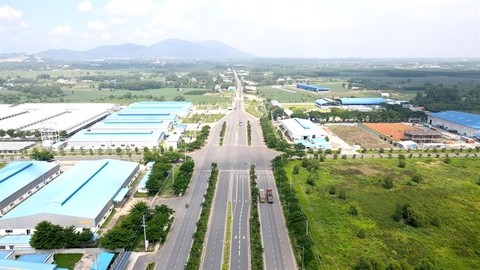
Bà Rịa - Vũng Tàu Province held a conference on March 30 to launch its 2021 – 2030 development plan and facilitate investment. — VNA Photo
Bà Rịa - Vũng Tàu Province has set out numerous development targets for 2030, including becoming a centrally-run city and developing its logistics and tourism sectors.
Bà Rịa - Vũng Tàu organised a conference on March 30 to launch its 2021 – 2030 development plan and facilitate investment, introducing the province’s strengths, development potentials and investment attraction priorities.
Phạm Viết Thanh, party secretary of the province, said that the locality has proven itself to be an important growth pole, being in the top five cities and provinces in terms of economy and provincial competitiveness index.
The investment into synchronous central and provincial infrastructure projects will allow the Southeast region and Bà Rịa – Vũng Tàu to realise their potential in industries, seaport, logistics, tourism and service in the next two years.
Bà Rịa – Vũng Tàu makes use of its natural advantages and has developed two new industries for the province, the chemical industry and renewable energy and wind power equipment manufacturing industry.
The 2021 - 2030 development plan with a vision towards 2050, approved on December 16, targets Bà Rịa – Vũng Tàu becoming a centrally-run city with an average gross regional domestic production (GRDP) per capita at US$18,000-18,500 by 2030.
It will also become a marine economy hub, a maritime service hub of the country and Southeast Asia, an international level tourism hub, and one of the largest industrial hubs of Việt Nam’s Southeast region.
By 2050, it targets net-zero emissions, contributing to Việt Nam’s commitment made to COP26.
Following the plan, it will focus on developing its Cái Mép – Thị Vải Port into an international transshipment port, setting up a free trade zone and building a national logistics hub linked with the seaport system in its Cái Mép Hạ area.
The province will develop large-scale industrial-urban-service complexes in Phú Mỹ Town (for which the province targets turning it into a city) and attract investment in petrochemical, electricity and electronics, robot manufacturing and artificial intelligence, among others.
It will also develop Vũng Tàu City to become a high-quality, world-class tourism hub, and completing the model of national tourist area and island eco-tourism urban area in Côn Đảo.
Deputy Prime Minister Trần Hồng Hà said that Bà Rịa – Vũng Tàu needs to become a leading region in green transformation, with its potential in wind energy, solar energy and gas-based energy.
It should have a roadmap for “greenifying” its industries and develop a circular economy model.
The province has identified four key industry groups for development, which are the industry sector; maritime economy and logistics service; tourism; and service industry linked with modern urban development.

The province’s Châu Đức Industrial Park. Bà Rịa – Vũng Tàu is one of Việt Nam’s leading regions in terms of economy. — VNA Photo
It will have seven new industrial parks and five new industrial clusters. By 2030, it will have a total of 24 industrial parks (covering a total area over 16,000ha) and 16 industrial clusters (547ha).
During the conference, 15 projects received approval for investment and capital adjustment, as well as certificates of investment registration. Five of them were foreign projects.
The province called for investment into its key industry groups, with 92 projects across many fields such as urban development, housing, tourism development, seaport and logistics development, and industrial park infrastructure.
Bà Rịa – Vũng Tàu currently has over 1,100 investment projects under operation, including 465 foreign projects with over $33 billion of total registered capital.
The first quarter of 2024 saw over $1.5 billion worth of FDI and VNĐ25 trillion of domestic investment poured into the province.
Bà Rịa – Vũng Tàu’s economy reached over VNĐ366 trillion in 2023, accounting for 3.51 per cent of the country’s GDP.
Its GRDP per capita in 2023 is over $8,000 per person per year, nearly doubling the country’s average. — VNS